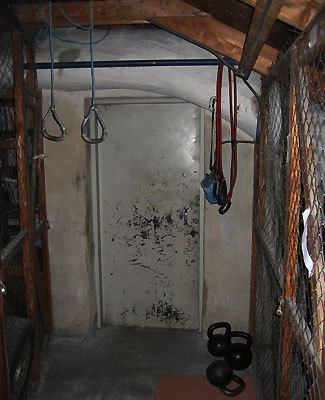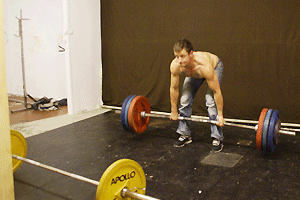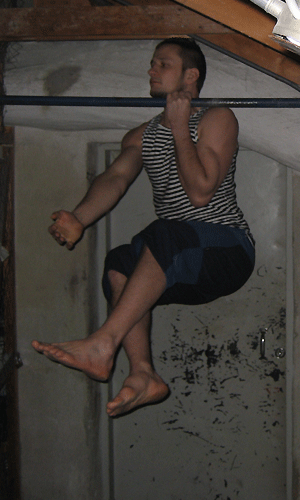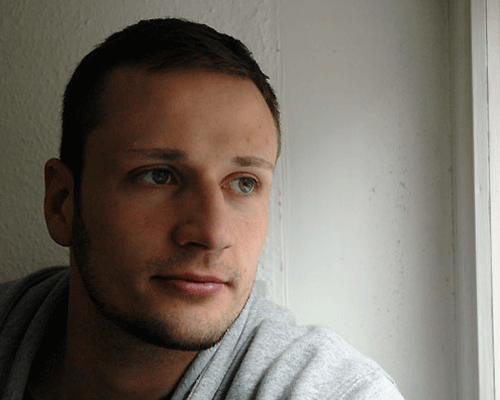Get the Most out of Strength Training
Anders Eriksson, RKC
May 28, 2008 01:10 PM
 Author's home-gym in the attic. Pull-up-bar, home-made rings, rubber-bands and kettlebells. Gym has outdoor temperature year around and is inhabited by a swarm of bats.
Author's home-gym in the attic. Pull-up-bar, home-made rings, rubber-bands and kettlebells. Gym has outdoor temperature year around and is inhabited by a swarm of bats.This is my method for achieving a training-goal, and taking the lessons that training has to teach. The only main goals I have achieved so far is the one-armed chin, the BW clean and jerk and the half BW kettlebell-press, but my process still helps me improve towards my other ones, such as the bodyweight bent-press, the BW olympic snatch and 100 consecutive KB-snatches with the 32kg bell.
GoalsThere is a trade-off in strength-training, in that if you first and foremost want to have fun and feel good you generally compromise results a little bit. I love going to the gym and goof around with hand-to-hand stuff, and a myriad of fun and challenging lifts. That kind of training would never have allowed me to reach my goal of a one-armd chin though. When I was 14 I couldn't do a single regular two-armed chin, so you see, in order to make that kind of improvement, I had to bee very focused and cut loose a lot of fun stuff that costs more than it tastes, and wouldn't have taken me closer to my goal. In order to reach a big goal, you also have to bust your butt a little more than what is comfortable, sometimes training with high intensity, high volume and frequency for a long period of time. If you want to get strong, or at least if you want to make a big improvement, as fast as possible, you have to accept that training won't always be fun or even make you feel good.
So the first thing you need to do when designing your excercise habits is choosing your goal wisely. Your choice of goal will dictate how you will live and train for a shorter or longer time to come. Pick a steep goal and you will either set yourself up for heavy monotone training you won't always be enjoy, or the frustration of never reaching the goal! Choose a goal, that you are able and willing to put the necessary time and effort in to!
For me ridding myself of "shoulds" were a breakthrough in my strength-training life. As a competitive fighter for many years, my training in the gym was alway dictated by what I needed to do to perform better in the ring or cage. After an injury and shelfing my MMA-carreer I could for the first time choose a strength-goal all by myself. Even if you are not an athlete it's easy to just do what everyone else does, and not pay attention to where your own preferences and wishes really lie. It's important though, because the only way you are going to stay motivated through the kind of long, difficult training that produces big gains relativly fast, is to work towards a goal that you really care about! For me, I've always been told I "should" squat, deadlift and bench-press. I did that stuff because I was supposed to, but (maybe with the exception of the deadlift) I never got a whole lot stronger. Part of it was because I used to train incorrectly, too infrequent, too low volume and going to failure all the time, but a large part of it also was that I never really busted my butt in training, simply because I never cared a whole lot about those lifts! I've always liked chins and dips though, and when I first decided to learn the muscle-up, and later the one armed chin, my strength took off for the first time ever, because they were my own goals. I was motivated and hungry to train hard and because I ditched the demanding squat and bench-sessions that I didn't really cared about either way, I had more time and energy, which made the difference between actually improving and not. Understand that you "shouldn't" do anything, not bench-press a certain % of your BW, not run a certain distance in a certain time, not even the rites of passage in Pavel's Enter the Kettlebell! What do you WANT to do? What lift would you like to be able to kick butt in? Do that, and ditch everything that you don't care about! Be realistic too, you won't be able to reach many different goals at the same time, especially if they demand different physical attributes, like max strength, speed and endurance. Pick something and forget about the rest. It's your life, and there are no musts or shoulds.
Your goal should be so sweet to you that no matter how boring or demanding your training gets, you should always be fired up and urging to go train by thinking about yourself achieving the goal, in my case the one-armed chin. There is nothing magical about that very skill, the important thing is to have a goal, any goal that truly motivates you. I believe this is why most gym-people never improve. Their goals are so abstract and so little thought-through that they just can't serve as proper motivation. They basicaly, by definition, don't even have goals! A goal should be quantifiable, (that is, you should clearly be able to tell if you reached your goal or not), and highly desirable. "Getting in shape" is not it.
 How things get done
How things get doneDiscipline and consistency is the most important things in order to produce results. You have got to put in the work, you must create habits that supports enough training and recovery, and you must keep it up for a long time if you are to reach your goals. Sometimes it will surly suck to go lift, sometimes you would rather do something else. You don't have to feel guilt and make excuses if you skip practice, simply accept that there is a price to be payed, and before it has been paid in full, you won't reach your goal. Noone else is going to care if you never reach your goal, it's completly up to you if that price is worth paying or not.
Gather knowledgeThe difference between a dream and a goal is that a goal has a method for reaching it. After you have selected a specifik goal, you need to come up with a method. You need knowledge about your goal. In order to create the correct partial goals, and eventually reach the end goal you must understand what specifik demands your goal raises, what kind of training develops the attributes to meet those demands, and what factors might hinder your progress.
Don't get stuck guessing, or designing your own method, because there are a lot of highly effective, well-designed methods out there allready. Somewhere some people are allready doing what you want to be able to do. Do what they do. When I first started to work towards a one arm chin I spent a lot of time changing my program back and forth, getting burned out from negatives and mess with different ways of assisting the one-armed chin. I'll tell you right now, had I just taken on a serious, tested pull-up program from the beginning I would have saved myself a lot of time and effort. It's easy to just start doing whatever you suppose will get you your goal, but this is a trap. You will progress faster with less work if you use a program designed by a professional, or at least an experienced coach or athlete. You don't have to be convinced your method is optimal, no programs are perfect for everyone. Chances are, if you start any good program, designed by a professional and put in the time and effort, you will be closer to your goal. Set up partial goals, as many as possible, and work towards them one by one.
Solving problems, dealing with failures, adapting and evolvingEvaluate your progress continuously. Be honest and throw out what doesn't produce results, what is not practical, what you can't do and what you can't recover from. Take a lesson from everything that you do, if something doesn't work out, figure out why, and what you should have done instead. If you have a breakthrough and develop rapidly, figure out why and how you can get that result again. All the programs and formats I have used has strengths and weaknesses, ask yourself what worked out good? What was problematic? make little tweaks as you go along and remember to take notes and evaluate.
Things won't always work out the way you planned, sometimes you can't lift as many days as you planned, sometimes you get injured or ill and can't train. Sometimes you busted your butt for five weeks but for some reason can't get that PR you hoped for. Learn from the setbacks too. Understand that every setback teaches you to deal with setbacks, in fact it teaches patience, flexibility and to not take things for granted. Know that nothing that's worth anything comes cheap and easy. If it did, it wouldn't be worth much right? The kicker with goals is that in the beginning, your goal seems so valuable that it motivates you to train hard. After a while it's the other way around, all the training and effort you put in, all the pain you endured, that's what gives the goal it's value. The more you invested in it the more it's worth!
Life-skills from strength-trainingI truly believe that if you take on an intelligent approach and an open mind, strength-training, just like martial arts, can become a school for life. Learning to recognize the skills and goals you truly feel for and ditch the "shoulds" and "musts" that people put on you, can translate to greater knowledge of self and confidence in a broader sense. Searching out new knowledge, and challenge your old ideas about training lets you learn and evolve, and that process carries over to other walks of life as well. Consistantly putting in work and sacrifice in order to reach a goal teaches discipline, persistance and dedication. Setbacks teaches patience and flexibility.
By breaking down the journey towards a goal in these steps, I have not only bagged strength-goals I thought was impossible, I have also found that training to be strong teaches me a bunch of valuable lessons and lets me practice deep personal skills that helps me deal with every aspect of my daily life better. My yoga-teacher used to tell me "The body is the ladder, on which the soul shall climb up", I didn't understand it at the time, because I wasn't ready for it, and passed it off as new age mumbo jumbo. But what he meant was, only when the body is strong, healthy and free from injuries and limitations can we reach our full potential mentally and spiritually, and physical training is also mental and spiritual training. I believe this insight makes for a long-term healthy relation, and continuing progress in strength-training.
My method:
Think through and choose your goal carefully. Goal has to be specific, measurable and highly motivating. Create partial goals.
Collect knowledge. Pavel's Naked Warrior and Power to the People! have the core-principles of building strength in them, clearly and simply explained, that's a great place to start! Don't waste time collecting every piece of info there is, get started, and adjust as you go!
Work consistantly, patiently and according to the knowledge you have collected, towards your goal. Monitor training-formats, your perception of them while training, and results.
Make small and controlled tweaks. Never stop gathering more knowledge and evolve. Carefully and critically evaluate everything you do.
Don't be a Nazi. Sometimes you can't or shouldn't train. Sometimes things won't turn out the way you wanted it to. Don't be like a stubborn little kid, deal with it, recognize that you can't control everything and that setbacks both teaches patience, and contributet to the value of your goal.
Keep your eyes, ears and mind open. Every part of training, from packing your bag and heading out in the rain even though you don't feel like it, to keeping up even when it doesn't seem to deliver, to surpassing your goals, it all has some lesson to teach you.Anders' Training Progression Towards the One-Arm Chin Starting out too eager, I used to do many different techniques, most of wich were more a waste of time and effort than anything else. One thing I did early that I believe prevented injuries later on though was weighted deadhangs (working up to a 10 sec. one-arm deadhang with 40kg/88lbs added).
Weighted chins was my main strength-builder all along. Every time I tried to go more into one-arm-pulling I hit a wall and wouldn't progress. Assisted one-armers, while necesary to get into the groove, is not a reliable strength-builder for me. I highly recomend the ladder-progression, outlined in Pavel's Enter the kettlebell for weighted chins. I worked up to a comfortable set of 5 with 50% of my bodyweight, and a max-single with 75% of my bodyweight added before I was ready to get results from assisted one-armers. When I had those numbers, it only took 4-5 weeks of practice to bag a true one-armed chin. Controling bodyweight was crucial.

About the Author:Being a weak and non-physical kid, who could not even do one two-armed chin at age 14, I started muay thai/kickboxing in 1994, where I slowly learnt the basic lessons of sports and fighting. I fought amateur shootfighting (held some amateur titles around the turn of the century), muay thai, submission wrestling and later pro MMA, all in all around 40 fights in the Nordic countries, US and Thailand. Having done many different strength-training methods and programs over the years, the first time I felt I could truly change my body and become physically strong was after a training-buddy and close friend brought back the book Power to the people! from a training-trip to San Diego, US in 2002 or 2003. Searching out Pavel's stuff later put me in contact with the RKC-comunity through Kenneth Jay, Tommy Eli and Camilla Silberbrandt in Denmark. I went deep into kettlebells and bodyweight strength-training after canceling my last MMA-fight (due to getting KO:d in practice 10 days out from the event) and became an RKC in 2005. I started over in BJJ in 2007 and recently got my blue belt from Francisco Neto and Pilo Stylin of the Yamasaki-team.
 Photo by Markus Lindberg
Photo by Markus Lindberg
Back